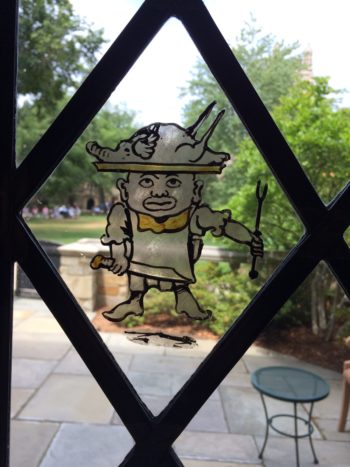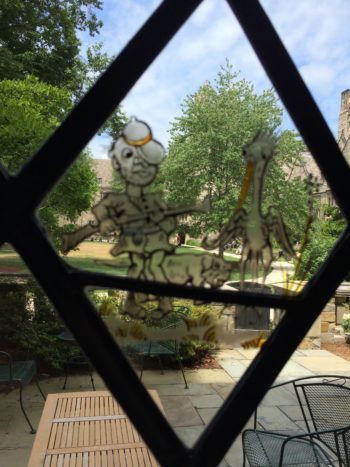
In the Calhoun College dining hall, high above tables where students sit engrossed in their food and conversation, five windowpanes are missing. In their places sit sheets of yellow glass. Walking out into the college’s common room, students might note that six more panels of glass have been replaced there too.
One of the dining hall windows was shattered in July by dining hall worker Corey Menafee, an incident first reported in the New Haven Independent. The others, along with two windowpanes from Branford College, were moved in July and August on the recommendation of the University’s Committee on Art in Public Spaces. They now await their future in framed boxes, deep in the archives of Yale’s libraries.
—
In the wake of student protests over the residential college naming decisions, Menafee’s window-shattering drew attention to campus artwork as another means of engaging with Yale’s controversial past. Yale President Peter Salovey sent a campuswide email on July 14 in response to the window-shattering incident, stating that he had commissioned the Committee on Art in Public Spaces to “undertake an inventory of public representations — such as stained-glass windows — throughout campus to determine if they are better viewed in the context of a historical exhibit.”
To current Yalies, the committee might seem like the administration’s attempt to address campus protests. In fact, it has existed since the early 2000s. It was revived last spring, with new members selected from the Yale University Art Gallery, the Yale Center for British Art, the History Department and the Yale administration.
The Committee first showed signs of renewed activity when Martha Highsmith, senior advisor to the president and co-chair of the committee, reached out to the student body in an email on May 6 asking for student responses to a survey on campus art. The committee received over 100 responses to the survey, but did not publicize any decision to remove or keep particular works of art on display until mid-September.
Martin Kersels, the committee’s other co-chair, a contemporary artist and a professor at the School of Art, hesitated to talk about the possible removal of existing campus art and declined to disclose information about what works of art have already been inspected or discussed. He said that the ultimate goal of the committee is to expand and diversify the University’s collection, not to take pieces away.
“We are not an art police by any means. We are here to carefully address what is here and not to whitewash the past, but to add to and raise questions about the past,” he said.
There has been debate within the Committee over whether to place a new piece of art in Calhoun memorializing its controversial history. Committee member Carol Snow, who is deputy chief conservator and senior conservator of objects at the YUAG, does not think that such an approach to the new windows would fully address the college’s problems.
The Committee’s most recent update to the Yale community indicated that there will soon be new windows installed in Calhoun College. Chairs Kersels and Highsmith wrote in a campuswide email on Sept. 16 that a new committee, composed of “faculty, staff, students from and the head of Calhoun College and alumni,” will “gather proposals and recommend an artist or artists to create work for Calhoun College.”
The Committee on Art in Public Spaces also formed a subcommittee to discuss whether the windows that were left intact after the Menafee incident should remain. Ultimately, the subcommittee advised the University to remove and relocate the most objectionable images, including one of a slave cabin and another two in Branford College that were racially offensive depictions of African Americans.





According to Snow, any art that the committee votes to remove will be available for the public to study. Of particular interest is the window Menafee smashed, the shards of which have been gathered and saved.
“As far as I know there is no intent to repair the glass and I believe it should stay broken as part of its history,” Snow said.
The Committee’s campuswide email on Sept. 16 also expressed the intention of installing contemporary Native American art on campus, which committee member Ned Blackhawk, a Western Shoshone history and American Studies professor, has been advising for months. The purpose of the art would be, in part, to honor the people who previously lived on the land Yale University was built upon.
This installation would come after the recent removal of a Native American mannequin from the Peabody Museum of Natural History, an act independent of the committee. The mannequin depicted a Native Connecticut figure working with stone tools, and had been on display at the Peabody since the 1980s. According to Peabody Museum Director David Skelly, the exhibit was confusing to visitors as it was oriented closer to the dioramas of animals and natural habitats than it was to the rest of the stone point exhibit. The mannequin, which is from the 1900s, is still available in storage as a means to study how Native people were represented.
“We are continually updating the Peabody’s displays,” he said. “Other renovation projects are in the planning stage.”
Also operating independently of the committee, Calhoun’s Head of College Julia Adams had three portraits of John C. Calhoun removed from the college in March, after the college’s yearlong discussion of the name came to an end. The portraits, two of which were in poor condition, are still being cleaned. Adams said the feedback she has received from students has been overwhelmingly positive, with many expressing relief at the portraits’ removal.
—
The co-chairs of the Committee for Art in Public Spaces both emphasized the committee’s desire for student input, which prompted them to form a new committee that will include students to decide the design of the new Calhoun dining hall windows. Until now, students have not served directly on the committee and have only been able to submit their opinions through an online form.
A few undergraduate students who spoke to the Mag said they did not have strong feelings on public art.
Prior to the September email, Phillip Hicks ’20 said he was neither aware of the committee’s existence nor of public art on campus, but he supports diversifying the University’s collection. He added he did not like the idea of removing existing art pieces.
Amrutha Dorai ’18 expressed tentative optimism at the prospect of the committee. She said she remembered that the email notifying students that Calhoun College would retain its name had mentioned that the University would add art to the college to commemorate the college’s legacy. She explained she did not think simply adding art was enough and worried the wrong art could serve to reinforce the college’s negative history. “If the right people are serving on the committee and putting thought into art on campus, it might create positive change,” Dorai explained.
After the Sept. 16 email, some students expressed excitement about the possibility of new art. Cameron Martel ’20 told the Mag he liked the idea of showing the diversity of the country through the acquisition of new campus art pieces. And Wei Tai Ting ’19 said he was excited to see more variety in the genre of art on campus.
“There is a lot of modern art by western artists on campus. on campus, so diversifying the public art holdings that we have makes Yale a culturally richer space,” he said.
As campus discourse continues, so will discussions within the Committee on Art in Public Spaces. And for students who have complaints about existing art — or a vision of what they want to replace it — now may be the time to speak up.
Correction: Wei Tai Ting was misquoted in the original article as having referred to surrealists







